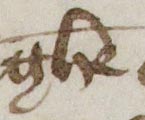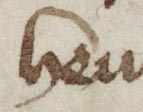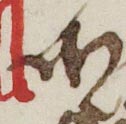|
| A |
 | Usage: and
single compartment 'a' with or without a horned effect at the head of the down-stroke. The scribe often turns his nib as he forms the left side of the graph. The lobe is then closed by a hairline stroke. |  | Usage: haue
the single compartment of 'a' is rectangular with finer connecting strokes for the sides. |
 | Usage: daye
the down-stroke has no turn at the head in this example. |  | Usage: And
double compartment upper case 'A' with flat head-stroke which gives a more angular aspect to the graph. |
|
| D |
 | Usage: depe
the scribe uses both a pointed and a rounded lower lobe for this graph. |  | Usage: and
a single example of unlooped 'd' on this folio. |
 | Usage: blissed
'd' in final position is often tagged. |  | Usage: god
the upper loop of 'd' extends back beyond the level of the rounded lower lobe. |
|
| G |
 | Usage: god
secretary 'g' is used throughout. The tail turns counter-clockwise. |  | Usage: mornyng
'g' in final position has a vertical tag which descends from the extended horizontal cross-stroke. |
 | Usage: highe |  | Usage: aged
the horizontal cross-stroke is not necessarily at the head of the graph. |
|
| H |
 | Usage: habounde
'h' is evenly formed with open head arching above the following graph. The shoulder comes off the lower part of the stem and the limb curves round minimally with tail-stroke which tucks beneath the base of the stem. |  | Usage: which
'h' is crossed after 'c', 't' and 'g'. |
 | Usage: sinketh |  | Usage: 'heuynesse
both head and tail strokes are extended in this example. |
|
| R |
 | Usage: rede
modern 'r' is used in all positions. The down-stroke is set at an oblique angle and the shoulder joins at or near the top. |  | Usage: your
the 'ur' at the end of this word. The 'r' is flourished, perhaps to suggest a final 'e'. |
 | Usage: grounde
'z'-shaped 'r' is used after vowels and also round-bodied graphs including 'g' and 'p'. |  | Usage: Ruthe
upper case 'R' used for this noun. |
|
| S |
 | Usage: saue
long 's' is used in initial and medial positions. The head-stroke in this example is a rather exaggerated one though in most examples it may extend above at least one graph. |  | Usage: this
kidney-shaped 's' in final position. |
 | Usage: confesse |  | Usage: was
a single example of sigma 's' in final position. |
|
| W |
 | Usage: wisly
the scribe's 'w's are evenly formed in cursive fashion. |  | Usage: now
the left limb is taller than the middle element. There is often a small curl as an approach to the thick descending left stroke. |
 | Usage: betwixt
there is a single lobe to the right. |  | Usage: Which
an upper case graph which also has a curving approach stroke to the left limb. |
|
| Y |
 | Usage: ye
the tail of 'y' varies in length. |  | Usage: wisly
unusually perhaps, the tail is continued up in a vertical line to end with a clockwise curl at the top above the level of surrounding graphs. |
| Usage: myn |  | Usage: Ye
there are several upper case 'Y's at the beginning of lines on this folio. They all have the looped approach stroke to the left limb of the graph. As if to emphasise its position as the first letter of the line, the left limb is far longer and more pronounced than on the lower case examples. |
|
| Upper Case Letters |
 | Usage: ffor
points at the head of these 'f's. |  | Usage: The
curled approach to the head stroke and an oblique stroke which decorates the main part of the letter. |
 | Usage: But
a spikey effect is created by the very angular 2-shaped element to begin, the pointed nature of the two bows and the vertical line which begins above the graph and bisects it. |  | Usage: I
'I' has a wavey stem topped by a punctus-type point with horizontal stroke to form the head. |
|
| More Upper Case Letters |
 | Usage: Of
two forms of upper case 'O' with vertical line decoration through the middle of the graph. In this example, the line bisects the graph and continues below it. |  | Usage: Of
in this example, the vertical line begins above the graph before running through it to rest on the lower curve of the letter. |
 | Usage: My |  | Usage: Myn |









































